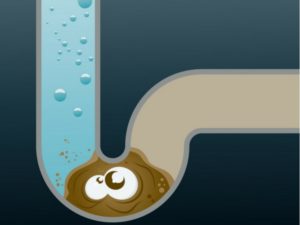If you find yourself dealing with foul-smelling drains or water within your home, there are solutions available to help you get to the bottom of any smelly issue quickly. Here are the three most common culprits of stinky drains and smelly water:
1. Ventilation Issues
Most homes are equipped with a ventilation system that allows sewer gas to effectively and easily move out of the home and into the outside air.
With an adequate balance of atmospheric pressure moving in, and sewer gas moving out, pressure is maintained.
But if there is a clog in the ventilation system, these sewer gases can back up and be forced back, and up through waste pipes.
These clogs can be caused by:
- Animal nests.
- Leaves.
- Debris.
If safe, you can attempt to remove these clogs by yourself. If the clogs are not accessible, or if conditions are not safe, call a plumbing professional immediately.
They have the tools and expertise to remove any clog safely.
2. A Stinky Water Heater
Are you noticing a smell of rotten eggs coming from your water supply all over your home? This unattractive issue is caused by an excess of bacteria living in the tank of your water heater.
These heaters provide the perfect moist and dark environment for bacteria to grow, even more so when there is a supply of sulfur within the water supply.
These bacteria can be killed by cleaning your water heater with H2O2, also known as hydrogen peroxide. The peroxide is safe for your water heater and the environment both, degrading into water and oxygen components.
If this solution does not work, consider your anode. Metal components within water heaters are usually made of aluminum or magnesium, which add to the smell when mixed with bacteria and sulfur. Install an anode made of both zinc and aluminum to combat the problem.
3. Dried Out P-Trap
Most pipes have a part known as the p-trap. This p-trap is the u-shaped piece of piping, containing a small amount of water at all times.
The water forms a seal that prevents sewer gases from backing up through your waste pipes, such as drains and toilets.
 Sometimes, these p-traps can back up from various issues, such as:
Sometimes, these p-traps can back up from various issues, such as:
- A leaky p-trap.
- Infrequent usage of certain pipes.
- A blockage in the p-trap, siphoning water out of the pipe and breaking the seal.
If there is a smell coming from a water drain that is rarely used, run water for a couple of minutes. This adds water back into the p-trap, and should eliminate the smell within minutes.
These smells can also come from commonly used pipes. If the smell is strong from one specific room in your home, inspect those drains for leaks or blockages, if accessible.
For drains that are inaccessible, or If you cannot find an issue, call your local plumber for help in determining the problem and finding the best solution.

